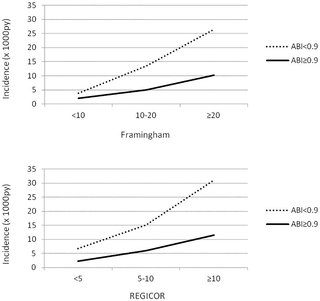PLOS ONE ( IF 2.9 ) Pub Date : 2018-01-16 , DOI: 10.1371/journal.pone.0191283 Rosa Forés 1, 2, 3 , Maria Teresa Alzamora 1, 2 , Guillem Pera 2 , José Miguel Baena-Díez 4, 5 , Xavier Mundet-Tuduri 3, 6 , Pere Torán 2

|
Background
The different cardiovascular risk prediction scales currently available are not sufficiently sensitive.
Aim
The aim of the present study was to analyze the contribution of the ankle-brachial index (ABI) added to the Framingham and REGICOR risk scales for the reclassification of cardiovascular risk after a 9-year follow up of a Mediterranean population with low cardiovascular risk.
Design and setting
A population-based prospective cohort study was performed in the province of Barcelona, Spain.
Method
A total of 3,786 subjects >49 years were recruited from 2006–2008. Baseline ABI was performed and cardiovascular risk was calculated with the Framingham and REGICOR scales. The participants were followed until November 2016 by telephone and review of the clinical history every 6 months to confirm the possible appearance of cardiovascular events.
Results
2,716 individuals participated in the study. There were 126 incidental cases of first coronary events (5%) during follow up. The incidence of coronary events in patients with ABI <0.9 was 4-fold greater than that of subjects with a normal ABI (17.2/1,000 persons-year versus 4.8/1,000 persons-year). Improvement in the predictive capacity of REGICOR scale was observed on including ABI in the model, obtaining a net reclassification improvement of 7% (95% confidence interval 0%-13%) for REGICOR+ ABI. Framingham + ABI obtained a NRI of 4% (-2%-11%).
Conclusion
The results of the present study support the addition of the ABI as a tool to help in the reclassification of cardiovascular risk and to confirm the greater incidence of coronary events in patients with ABI < 0.9.
中文翻译:

踝臂指数对改善冠状动脉风险预测的贡献:ARTPER 队列
背景
目前可用的不同心血管风险预测量表的敏感性不够。
目的
本研究的目的是在对心血管风险较低的地中海人群进行 9 年随访后,分析添加到 Framingham 和 REGICOR 风险量表中的踝臂指数 (ABI) 对心血管风险重新分类的贡献。
设计与设置
在西班牙巴塞罗那省进行了一项基于人群的前瞻性队列研究。
方法
2006 年至 2008 年期间,总共招募了 3,786 名 3E49 岁的受试者。进行基线 ABI 并使用 Framingham 和 REGICOR 量表计算心血管风险。通过电话对参与者进行随访直至 2016 年 11 月,并每 6 个月回顾一次临床病史,以确认可能出现的心血管事件。
结果
2,716 人参与了这项研究。随访期间有 126 例偶发首次冠状动脉事件(5%)。 ABI <0.9 患者的冠状动脉事件发生率是 ABI 正常受试者的 4 倍(17.2/1,000 人年 vs 4.8/1,000 人年)。在模型中包含 ABI 后,观察到 REGICOR 量表的预测能力有所提高,REGICOR+ ABI 的净重分类提高了 7%(95% 置信区间 0%-13%)。 Framingham + ABI 的 NRI 为 4% (-2%-11%)。
结论
本研究的结果支持添加 ABI 作为一种工具,以帮助对心血管风险进行重新分类,并确认 ABI < 0.9 患者的冠状动脉事件发生率较高。











































 京公网安备 11010802027423号
京公网安备 11010802027423号